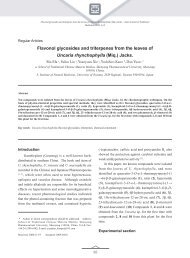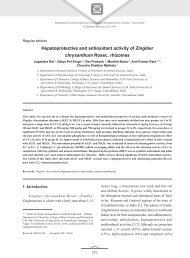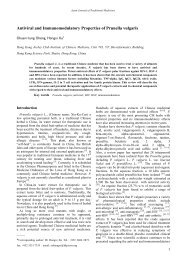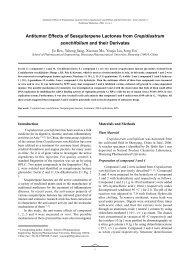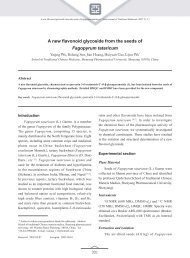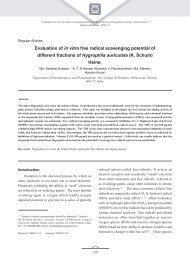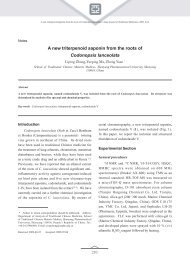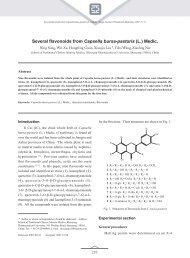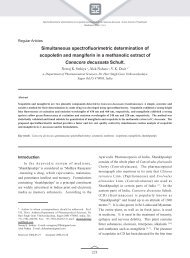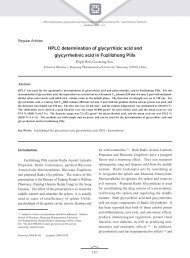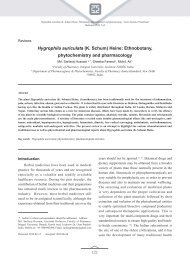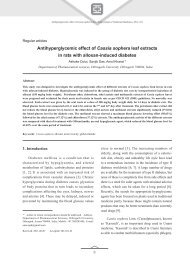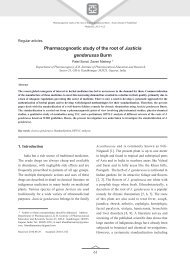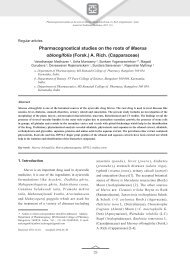Antimicrobial activity of Calophyllum inophyllum crude extracts ...
Antimicrobial activity of Calophyllum inophyllum crude extracts ...
Antimicrobial activity of Calophyllum inophyllum crude extracts ...
You also want an ePaper? Increase the reach of your titles
YUMPU automatically turns print PDFs into web optimized ePapers that Google loves.
<strong>Antimicrobial</strong> <strong>activity</strong> <strong>of</strong> <strong>Calophyllum</strong> <strong>inophyllum</strong> <strong>crude</strong> <strong>extracts</strong> obtained by pressurized liquid extraction / AsianJournal <strong>of</strong> Traditional Medicines, 2009, 4 (4)abundance in Vietnam.There is an explosion <strong>of</strong> interest in naturalantimicrobials from plant sources due to the rise <strong>of</strong>multidrug resistant strains <strong>of</strong> bacteria such as MRSA,VRE and multidrug resistant tuberculosis [2] . Thus,rapid screening techniques are essential to quicklyidentify and isolate these compounds. Conventionalsolvent extraction techniques have severaldisadvantages in terms <strong>of</strong> high volumes <strong>of</strong> organicsolvents consumed and long extraction times.Modern extraction techniques, such as pressurizedliquid extraction (PLE), seek to circumvent theselimitations. At the high pressures employed,extraction can be carried out above the boiling point<strong>of</strong> the solvent, which remains in the liquid phase,allowing better diffusion and improved mass transferkinetics [3] . This drastically reduces the amount <strong>of</strong>organic solvent used as well as the extraction time,from a period <strong>of</strong> hours to only minutes. PLE also<strong>of</strong>fers the possibility <strong>of</strong> performing extractions inan inert atmosphere protected from light, whichrepresents an advantage since phenolic compounds arevery sensitive to these two factors [4] .<strong>Calophyllum</strong> <strong>inophyllum</strong> fruit is used to extractoil. The oil has been proven to have vulnerary andcicatrising effects [5] . The fruit peel is <strong>of</strong>ten discardedas waste. To our knowledge, there is no studycurrently available on the antimicrobial properties<strong>of</strong> the <strong>Calophyllum</strong> <strong>inophyllum</strong> fruit peel. Thus,this paper describes a study aimed to establish (1)PLE as a rapid extraction method for obtainingbioactive principles from botanical material, and (2)to investigate the potential <strong>of</strong> <strong>Calophyllum</strong> <strong>inophyllum</strong>fruit peel as a source <strong>of</strong> antimicrobial compounds.Materials and methodsPlant materialsThe dried fruit peels <strong>of</strong> <strong>Calophyllum</strong> <strong>inophyllum</strong>were collected in December 2008 from Ben Treprovince which is situated about 80 km from Ho ChiMinh City, Vietnam.Pressurized liquid extractionThe plant material was pulverized using a Fitzmill (M5A, Fitzpatrick, USA) and sieved to obtaina powder with a median particle size <strong>of</strong> 1.84 mm [6] .Then, 5 g <strong>of</strong> the milled material was extracted byPLE (ASE-100, Dionex, USA) and the dead space inthe extraction vessel was minimized using 1-2 mmglass beads. Glass wool and 10 µm frits were placedat each end <strong>of</strong> the extraction vessel to prevent finescontaminating the extract. Extraction was carriedout at a fixed pressure <strong>of</strong> 1500 psi, a temperature <strong>of</strong>120 °C, and for a period <strong>of</strong> 15 min. A single cycle<strong>of</strong> extraction was used. Flush volume <strong>of</strong> 60 % anda nitrogen purge time <strong>of</strong> 90 s were used to rinse theequipment <strong>of</strong> any entrapped extract to enable a moreaccurate quantitative recovery.Soxhlet extractionSoxhlet extraction was conducted usingan automated Soxhlet extractor (B-811, Buchi,Switzerland). For this, 1 g milled material wasaccurately weighed and placed in a cellulose thimble(25 mm×27 mm×100 mm, Whatman, UK) andextraction was performed using methanol and n-hexanefor 8 h.Preparation <strong>of</strong> dried <strong>extracts</strong>The <strong>extracts</strong> obtained from both PLE and theSoxhlet extraction were dried under reduced pressureunder ambient conditions using a rotary evaporator(Eyela, Japan). The yield <strong>of</strong> extract, expressed as theweight ratio over the weight <strong>of</strong> raw material used, wascalculated. The <strong>extracts</strong> were stored in airtight vialsand kept refrigerated (2-8 °C) until further analysis.Screening <strong>of</strong> phenolic compoundsThin-layer chromatography was carried outusing thin-layer chromatography (TLC) plates <strong>of</strong> precoatedsilica-gel 60 F 254on aluminum sheets (Merck,Germany). Development <strong>of</strong> the TLC plates was142



